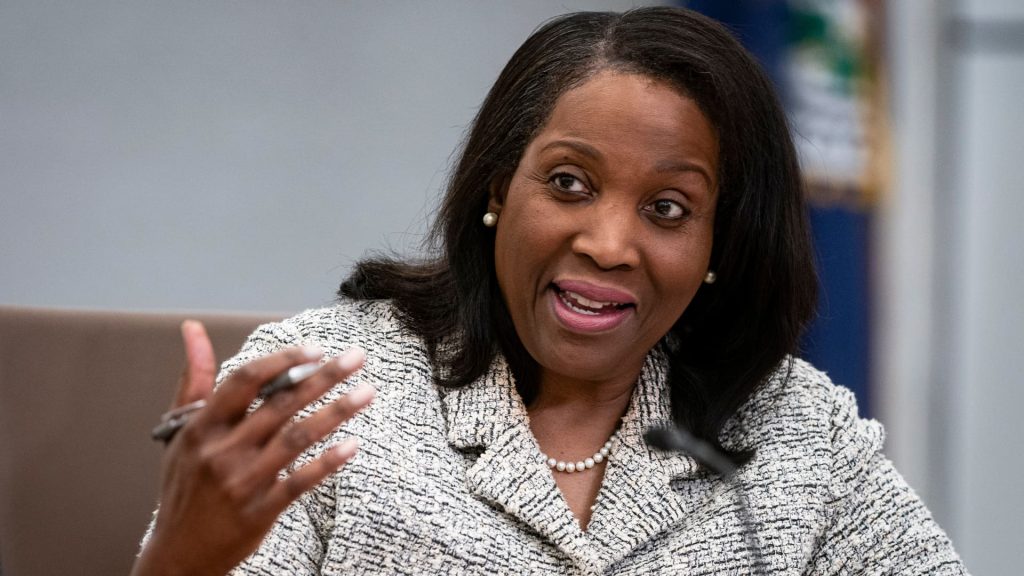Federal Reserve Governor Lisa Cook has recently voiced concerns regarding inflation and its potential implications for the U.S. economy. Speaking before the Council of Foreign Relations, Cook highlighted challenges posed by trade policy and tariffs that could affect labor markets and price stability. As inflation rates fluctuate, the Federal Reserve’s strategies surrounding interest rates will be closely scrutinized in the coming weeks, particularly as the Fed’s next policy meeting approaches.
| Article Subheadings |
|---|
| 1) Concerns Over Inflation Trends |
| 2) The Impact of Trade Policies |
| 3) Federal Reserve’s Upcoming Decisions |
| 4) Expert Opinions on Future Rate Cuts |
| 5) Summary of Economic Outlook |
Concerns Over Inflation Trends
During a recent address, Lisa Cook expressed unease regarding current inflation rates, which have seen some improvement yet remain susceptible to fluctuations. As of April 2024, core inflation stood at 2.5%, with the overall headline inflation at 2.1%, as reported by the Federal Reserve’s preferred measures. Despite this progress, Cook emphasized that even slight upticks in costs could pose challenges to maintaining economic stability.
The persistence of inflation can be attributed to various factors, including supply chain disruptions and increasing consumer demand post-pandemic. Cook’s analysis suggests that although there are signs of stabilization, the potential for rising prices could hinder further progress towards targeted inflation levels. She noted that consumer and business behavior may shift in response to previous inflationary experiences, leading to a cycle of wage and price increases.
The Impact of Trade Policies
Cook highlighted the significant role that trade policy plays in shaping economic conditions. The tariffs imposed under the previous administration could lead to increased production costs, which may not only affect inflation but also weigh on the labor market. According to Cook, while she does not take a formal stance on these policies, she monitors their economic implications closely.
The ongoing tensions in international trade could result in sustained price pressures, thereby complicating efforts to maintain low inflation. Cook noted, “Price increases tied to changes in trade policy may make it difficult to achieve further progress in the near term.” This creates an environment of uncertainty as businesses balance costs against consumer expectations for pricing.
Federal Reserve’s Upcoming Decisions
With the Federal Reserve’s next policy meeting scheduled for June 17-18, market speculation is rife regarding potential interest rate adjustments. Current indicators suggest the Fed is likely to maintain the status quo, with analysts anticipating that any future cuts will not occur until September, depending on the unfolding economic landscape.
In her speech, Cook refrained from indicating a specific timeline for rate easing, underscoring the Fed’s focus on remaining agile in response to varying economic pressures. “I see the U.S. economy as still being in a solid position,” she stated, while acknowledging the heightened uncertainties that could impact both inflationary trends and unemployment rates.
Expert Opinions on Future Rate Cuts
In discussions surrounding future interest rate cuts, Fed officials have varied in their predictions. Raphael Bostic, Atlanta Fed President, indicated a cautious approach, projecting only one cut for the year based on current inflation indicators. This outlook contrasts somewhat with that of Christopher Waller, who anticipated more favorable conditions for rate cuts as economic impacts of tariffs may prove less severe than expected.
These divergent perspectives highlight the complexities faced by the Federal Reserve as it navigates both current economic conditions and anticipates future shifts, especially with the balancing act required to maintain its dual mandate of full employment and stable prices.
Summary of Economic Outlook
As the economic landscape remains in flux, Cook’s comments serve as a reminder of the challenges policymakers face. The interplay of inflation, trade policy, and labor market conditions will be pivotal in shaping the Federal Reserve’s strategies moving forward. The potential rain from tariffs and ongoing international trade developments continues to be a significant concern for both economists and policymakers alike.
Overall, the Fed is confronted with a dual mission: mitigating inflation while fostering employment, all within a climate of uncertainty that may influence their decisions in the months ahead. Cook’s observations and the responses of her fellow policymakers will be crucial as they chart a course through these economic challenges.
| No. | Key Points |
|---|---|
| 1 | Federal Reserve Governor Lisa Cook expresses concern over inflation trends. |
| 2 | Trade policies, particularly tariffs, could negatively influence inflation and the labor market. |
| 3 | Expectations are high that the Fed will maintain interest rates in its upcoming meeting. |
| 4 | Divergent opinions among Fed officials on the timing of future rate cuts. |
| 5 | The overall economic outlook remains cautiously optimistic amid heightened uncertainty. |
Summary
In conclusion, the commentary from Lisa Cook emphasizes the ongoing challenges associated with inflation and the broader economic implications of trade policies. As the Federal Reserve grapples with these factors, it will need to remain vigilant and flexible, responding to both immediate economic data and longer-term trends. The decisions made in the coming months will be critical in shaping the trajectory of the U.S. economy.
Frequently Asked Questions
Question: What is the current state of inflation in the U.S.?
As of April 2024, core inflation is reported at 2.5% while the overall headline inflation stands at 2.1%. These readings indicate a mixed yet cautiously optimistic trend in inflation rates.
Question: How do trade policies affect the economy?
Trade policies, particularly tariffs, can increase production costs for businesses, which may lead to higher prices for consumers and impact overall inflation rates. This can also have repercussions for the labor market.
Question: What are the expectations for interest rates in the near future?
Market expectations indicate that the Federal Reserve will likely keep interest rates steady during the upcoming policy meeting in June. However, some analysts anticipate potential cuts could occur later in September, depending on economic conditions.
